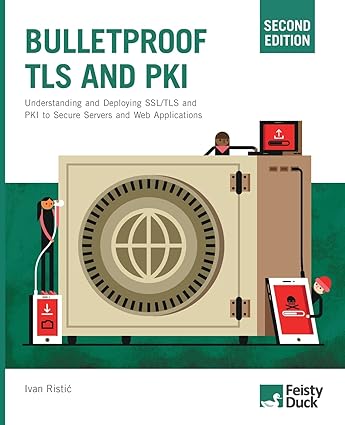Bulletproof TLS and PKI, Second Edition: A Comprehensive White Paper
Introduction
In today's digital landscape, securing servers and web applications is paramount. Transport Layer Security (TLS) and its predecessor, Secure Sockets Layer (SSL), have become the standard mechanisms for ensuring secure communication and data protection over the internet. This white paper, based on "Bulletproof TLS and PKI, Second Edition," provides a comprehensive overview of TLS/SSL and Public Key Infrastructure (PKI), exploring their inner workings, deployment best practices, and crucial considerations for achieving robust security.
Understanding TLS/SSL
TLS/SSL protocols are designed to provide:
- Confidentiality: Encrypting data exchanged between clients and servers, preventing unauthorized access.
- Integrity: Ensuring data remains unaltered during transmission, detecting any tampering or corruption.
- Authentication: Verifying the identity of servers and, optionally, clients, establishing trust in communication.
Key Concepts
- Cipher Suites: A combination of cryptographic algorithms that define how data is encrypted and authenticated during a TLS/SSL session.
- Certificates: Digital documents issued by trusted Certificate Authorities (CAs) that bind a public key to an entity's identity, enabling authentication.
- TLS Handshake: The process where clients and servers negotiate TLS/SSL parameters, including cipher suite and certificate exchange, before secure communication begins.
Deploying TLS/SSL
Implementing TLS/SSL involves:
- Obtaining Certificates: Selecting the appropriate type of certificate (e.g., Domain Validated, Organization Validated, Extended Validation) and requesting it from a trusted CA.
- Configuring Servers: Installing the certificate and configuring the server to use TLS/SSL, including selecting preferred cipher suites and protocols.
- Optimizing Performance: Implementing techniques like session resumption and OCSP stapling to minimize latency and improve user experience.
Public Key Infrastructure (PKI)
PKI is the framework that supports the issuance and management of digital certificates. It comprises:
- Certificate Authorities (CAs): Entities responsible for verifying identities and issuing certificates.
- Registration Authorities (RAs): Assist CAs in verifying certificate requests.
- Certificate Revocation Lists (CRLs): Lists of revoked certificates, maintained to ensure only valid certificates are trusted.
Best Practices for Secure Deployment
- Use Strong Ciphers and Protocols: Prioritize modern and secure cipher suites and TLS versions (e.g., TLS 1.2 or later) while disabling older, vulnerable ones.
- Regularly Update Certificates: Renew certificates before they expire to maintain uninterrupted secure communication and avoid browser warnings.
- Implement Certificate Revocation: Use mechanisms like CRLs or OCSP to quickly revoke compromised certificates, preventing their misuse.
- Secure Private Keys: Protect private keys with strong passwords, access controls, and secure storage mechanisms like Hardware Security Modules (HSMs).
- Monitor and Audit: Continuously monitor TLS/SSL connections and audit certificate usage to identify potential vulnerabilities and ensure compliance.
Conclusion
Deploying robust TLS/SSL and PKI is essential for securing servers and web applications. By understanding the core concepts, following deployment best practices, and staying informed about emerging threats and vulnerabilities, organizations can establish secure communication channels, protect sensitive data, and maintain user trust.
References
- Bulletproof TLS and PKI, Second Edition: Understanding and Deploying SSL/TLS and PKI to Secure Servers and Web Applications by Ivan Ristić
- RFC 5246: The Transport Layer Security (TLS) Protocol Version 1.2
- RFC 6125: Representation and Verification of Domain-Based Application Service Identity within Internet Public Key Infrastructure Using X.



